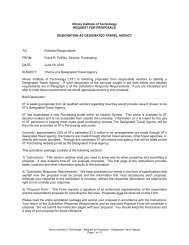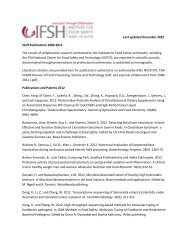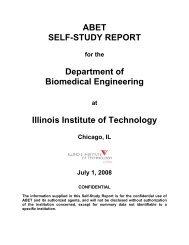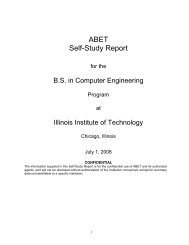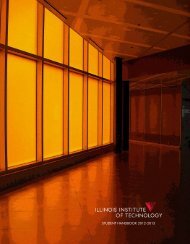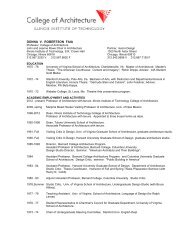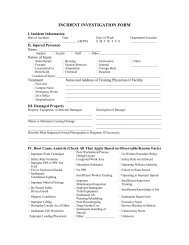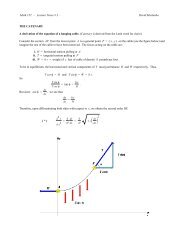Undergraduate Bulletin - Illinois Institute of Technology
Undergraduate Bulletin - Illinois Institute of Technology
Undergraduate Bulletin - Illinois Institute of Technology
Create successful ePaper yourself
Turn your PDF publications into a flip-book with our unique Google optimized e-Paper software.
Biomedical Engineering<br />
Cell and Tissue Engineering<br />
This area involves the more recent attempts to understand<br />
and attack biomedical problems at the microscopic level<br />
and to use such knowledge to begin to “engineer” replacement<br />
tissues and organs from individual cells. Knowledge<br />
<strong>of</strong> anatomy, biochemistry, and the mechanics <strong>of</strong> cellular and<br />
sub-cellular structures is necessary in order to understand<br />
disease processes and to be able to intervene at very specific<br />
sites. With such knowledge a number <strong>of</strong> approaches<br />
have been or are being developed. These range from the development<br />
<strong>of</strong> miniature devices to deliver compounds that<br />
can stimulate or inhibit cellular processes at precise target<br />
locations in order to promote healing or inhibit disease formation<br />
and progression to the newer techniques that have<br />
produced replacement skin and one day will produce heart<br />
valves, coronary vessels, and even whole hearts. This area<br />
also includes the development <strong>of</strong> artificial materials used for<br />
implantation. Understanding the properties and behavior<br />
<strong>of</strong> living material is vital in the design <strong>of</strong> implant materials.<br />
The use <strong>of</strong> placing materials in the human body for healing<br />
or repair has been practiced for over 100 years, but it<br />
remains one <strong>of</strong> the most difficult tasks faced by the biomedical<br />
engineer. Certain metal alloys, ceramics, polymers, and<br />
composites have been used as implantable materials. Biomaterials<br />
must not only function normally over the lifespan<br />
<strong>of</strong> the recipient but also be nontoxic, non-carcinogenic,<br />
chemically inert, stable, and sufficiently strong to withstand<br />
the repeated forces <strong>of</strong> a lifetime. Few materials meet<br />
all such specifications. Newer biomaterials are being developed<br />
which incorporate proteins or living cells in order<br />
to provide a truer biological and mechanical match for the<br />
living tissue.<br />
Bachelor <strong>of</strong> Science in Biomedical Engineering: Cell and Tissue Engineering Track<br />
Required Courses<br />
Credit Hours<br />
Biomedical Engineering Core Requirements 21<br />
BME 100, 200, 310, 315, 320, 330, 405, 419, 420, 490<br />
Cell and Tissue Engineering Requirements 42<br />
CS 115, MMAE 200, MS 201, ECE 215, CHEM 237, 239, CHE 202, ENVE 426, BME 301, 335, 418,<br />
482, two BME electives (six credit hours)<br />
Mathematics Requirements 18<br />
MATH 151, 152, 251, 252<br />
Physics Requirements 8<br />
PHYS 123, 221<br />
Chemistry Requirements 8<br />
CHEM 124, 125<br />
Biology Requirements 7<br />
BIOL 115, 117, 430<br />
Interpr<strong>of</strong>essional Projects 6<br />
Humanities and Social Science Requirements 21<br />
For general education requirements, see page 25.<br />
Total Hours 131<br />
62



